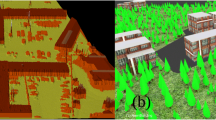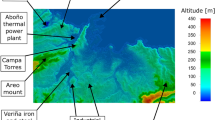Abstract
Landfill sites have been the most common way of eliminating solid urban waste, as well as that of public and mining wastes. Landfill sites are a constant source of environmental pollution and wind is the most important contributing factor to air pollution, due to the erosion which it produces over the landfill site surfaces, transporting dust away from the source point. This causes serious risks for human health and general dirt in the surrounding areas of the landfill site. The result of dust air pollution produced in a landfill site is analysed through CFD3D (Computational Fluid Dynamics) by joining the LIDAR (Light Detection and Ranging) technique and Ansys CFX 10.0 software. The CFD simulations determine the wind velocity distribution on the landfill site surface and the different particle threshold friction velocities which determine the dust emission in multiphase simulations (air-particles). These simulations are validated from field data obtained in three measurement programmes for each type of landfill site surface treatment which has been studied. It was determined that the superficial landfill site treatment with the lowest air pollution is tall grass and bushes. The methodology used can be applied to the dust emission calculation in the design or evaluation of other landfill sites.
Similar content being viewed by others
References
Nolasco D, Lima RN, Hernández PA, Pérez NM (2008) Non-controlled biogenic emissions to the atmosphere from Lazareto landfill, Tenerife, Canary Islands. Environ Sci Pollut Res 15(1): 51–60
Drew GH, Smith R, Gerard V, Burge C, Lowe M, Kinnersley R, Sneath R, Longhurst PJ (2007) Appropriateness of selecting different averaging times for modelling chronic and acute exposure to environmental odours. Atmos Environ 41(13): 2870–2880
Ritzkowski M, Heyer KU, Stegmann R (2006) Fundamental processes and implications during in situ aeration of old landfills. Waste Manag 26: 356–372
Sloss LL, Smith IM (2002) PM10 and PM2,5 legislation, measurement and control. Int J Environ Pollut 17(1/2): 157–169
Krajewski JA, Tarkowski S, Cyprowski M, Buczyñska A (2000) Characteristics of jobs and workers employed in municipal waste collection and disposal by the city of Lodz. Med Pract 51(6): 615–624
Musson SE, Xu Q, Townsend TG (2008) Measuring the gypsum content of C&D debris fines. Waste Manag 28: 2091–2096
Toraño J, Rodriguez R, Diego I, Rivas JM, Pelegry A (2007) Influence of the pile shape on wind erosion. CFD emission simulation.. Appl Math Model 31(11): 2487–2502
Alvarez JT, Alvarez ID, Lougedo ST, Hevia BG (2007) A CFD Lagrangian particle model to analyze the dust dispersion problem in quarries blast. WIT Trans Eng Sci (Multiphase Flow IV) 56: 113–121
Diego I, Pelegry A, Torno S, Toraño J, Menendez M (2009) Simultaneous CFD evaluation of wind flow and dust emission in open storage piles. Appl Math Model 33: 3197–3207
Sithole G, Vosselman G (2004) Experimental comparison of filter algorithms for bare-Earth extraction from airborne laser scanning point clouds. ISPRS Photogramm Remote Sens 59: 85–101
Baltsavias EP (1999) Airborne laser scanning: basic relations and formulas. ISPRS J Photogramm Remote Sens 54: 199–214
ANSYS CFX-Solver, Release 10.0: Theory (2008) Turbulence and wall function theory: Turbulence Models, p 69
Lee SJ, Lim HCh (2001) A numerical study on flow around a triangular prism located behind a porous fence. Fluid Dyn Res 28: 209–221
Kim HG, Lee ChM, Lim HC, Kyong NH (1997) An experimental and numerical study on the flow over two-dimensional hills. J Wind Eng Ind Aerodyn 66: 17–33
Tiwary A, Morvan HP, Colls JJ (2005) Modelling the size-dependent collection efficiency of hedgerows for ambient aerosols. J Aerosol Sci 37: 990–1015
Mallet C, Bretar F (2009) Full-waveform topographic lidar: state-of-heart. ISPRS J Photogramm Remote Sens 64: 1–16
Haala N, Brenner C, Anders KH (1998) 3D urban GIS from laser altimeter and 2D map data. ISPRS J Photogramm Remote Sens 32: 339–346
ANSYS ICEMCFD 10.0, Tutorial manual (2008) Tetra meshing p 309–310
US EPA (1988) Update Of fugitive dust emissions factors. In: AP-42 Section 11.2 wind erosion, MRI No. 8985-K. Midwest Research Institute, Kansas City, MO
ANSYS CFX-Solver, Release 10.0: particle transport theory (2008) Lagrangian tracking implementation, p 174
US EPA Sections 13.2.4 and 13.2.5 (1988) Compilation of air pollutant emission factors
Toraño J, Torno S, Menéndez M, Gent M (2009) Dust emission calculations in open storage piles. Environ Fluid Mech 9: 493–507
Diego I, Toraño J, Torno S, García B (2008) Experimental tests and computational fluid dynamics (CFD) simulations of barriers installed around open storage piles of raw materials. WIT Trans Eng Sci (Adv Fluid Mech VII) 59: 101–109
Blight GE (2008) Wind erosion of waste impoundments in arid climates and mitigation of dust pollution. Waste Manag Res 26: 523–533
Stunder BJB, Arya SPS (1988) Windbreak effectiveness for storage piles fugitive dust control: a wind tunnel study. J Air Pollut Control Assoc 38: 135–143
Pasquill F, Smith FB (1983) Atmospheric diffusion, 3rd edn. Wiley, Chichester
Author information
Authors and Affiliations
Corresponding author
Rights and permissions
About this article
Cite this article
Torno, S., Toraño, J., Menendez, M. et al. Prediction of particulate air pollution from a landfill site using CFD and LIDAR techniques. Environ Fluid Mech 11, 99–112 (2011). https://doi.org/10.1007/s10652-010-9187-7
Received:
Accepted:
Published:
Issue Date:
DOI: https://doi.org/10.1007/s10652-010-9187-7




